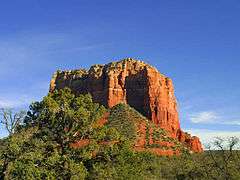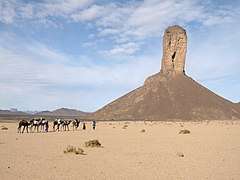Butte
In geomorphology, a butte (/bjuːt/) is an isolated hill with steep, often vertical sides and a small, relatively flat top; buttes are smaller landforms than mesas, plateaus, and tablelands. The word butte comes from a French word meaning "small hill"; its use is prevalent in the Western United States, including the southwest where mesa is used for the larger landform. Because of their distinctive shapes, buttes are frequently landmarks in plains and mountainous areas. In differentiating mesas and buttes, geographers use the rule of thumb that a mesa has a top that is wider than its height, while a butte has a top that is narrower than its height.[1]
Notable buttes
The Mitten Buttes of Monument Valley in Arizona are two of the most distinctive and widely recognized buttes. Monument Valley and the Mittens provided backgrounds in scenes from many western-themed films, including seven movies directed by John Ford.[note 1] The Devils Tower in northeastern Wyoming is a laccolithic butte composed of igneous rock rather than sandstone, limestone or other sedimentary rocks.[2]
Three other notable formations that are either named butte or may be considered buttes even though they do not conform to the formal geographer's rule are Scotts Bluff in Nebraska which is actually a collection of five bluffs, Crested Butte which is a 12,168 ft (3,709 m) mountain in Colorado, and Elephant Butte which is now an island in Elephant Butte Reservoir in New Mexico.
Among the well-known non-flat-topped buttes in the United States are Bear Butte, South Dakota, Black Butte, Oregon, and the Sutter Buttes in California. In many cases, buttes have been given other names that do not use the word butte, for example, Courthouse Rock, Nebraska. Also, some large hills that are technically not buttes have names using the word butte, examples of which are Kamiak Butte and Chelan Butte in Washington state.
Formation
Buttes form by weathering and erosion when hard caprock overlies a layer of less resistant rock that is eventually worn away. The harder rock on top of the butte resists erosion. The caprock provides protection for the less resistant rock below from wind abrasion which leaves it standing isolated. As the top is further eroded by abrasion and weathering, the excess material that falls off adds to the scree or talus slope around the base. On a much smaller scale, the same process forms hoodoos.[3]
Gallery

- Qaxaç Qalası or Kachaghakaberd fortress, Khojali District, Azerbaijan


See also
- Caprock Escarpment
- Megalith – Large stone used to build a structure or monument
- Monadnock
- Monolith – Stone block made of one single piece; object made of one single rock piece.
- Potrero – A long mesa that at one end slopes upward to higher terrain.
- Table mountain (disambiguation)
- Tepui – A table-top mountain or mesa in the Guiana Highlands of South America
- Tuya – A flat-topped, steep-sided volcano formed when lava erupts through a thick glacier or ice sheet
- Volcanic plug – Volcanic object created when magma hardens within a vent on an active volcano
Footnotes
- The John Ford westerns with location work shot in Monument Valley were Stagecoach (1939), My Darling Clementine (1946), Fort Apache (1948), She Wore a Yellow Ribbon (1949), The Searchers (1956), Sergeant Rutledge (1960), and Cheyenne Autumn (1964).
References
- "Mesa and Butte". Science Clarified. 2008. Archived from the original on 2 December 2013.
- "Devils Tower National Monument – Geologic Formations". National Park Service. 10 Mar 2014. Retrieved 13 Mar 2014.
- Davis, George Herbert (1999). Structural Geology of the Colorado Plateau Region of Southern Utah, with Special Emphasis on Deformation Bands. G.S.A. Special Paper 342. Boulder, Colorado: Geological Society of America. p. 30. ISBN 978-0-8137-2342-6.
External links
| Wikimedia Commons has media related to Buttes. |
| Look up butte in Wiktionary, the free dictionary. |

- . New International Encyclopedia. 1905.

_1.1_(by).jpg)